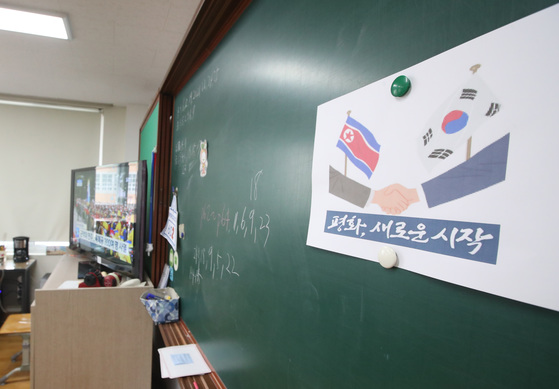
At the time of the inter-Korean summit in April 2018, an elementary school in Busan was conducting an opportunity education for peaceful unification. Central photo
Six out of 10 students answered that unification is necessary, but on the contrary, the number of students who consider it unnecessary is increasing.
On the 8th, the Ministry of Education announced the results of the ‘2020 School Unification Education Survey’ conducted in November of last year, targeting 68,750 students from elementary, middle and high schools nationwide. This survey has been conducted with the Ministry of Unification every year since 2014.
“North Korea is’objects to cooperate with’ rather than’border targets'”

Some of the results of the 2020 school unification education survey. Provided by the Ministry of Education
When asked,’What kind of object do you think North Korea is to us’, 54.7% of students answered that’the object to cooperate with’. This increased significantly from the previous year (43.8%), and is higher than in 2018 (50.9%) when the inter-Korean summit was held. The number of students who think that North Korea is an’object to be vigilant’ decreased by 11.6%p from the previous year to only 24.2%.
Both positives and negatives increased regarding the necessity of unification. The number of students who answered that unification is’necessary’ increased significantly from the previous year (55.5%) to 62.4%, similar to 2018 (63.0%). However, more and more students had opposite thoughts. The number of students who answered that unification was’not necessary’ was 13.7% in 2018 and 19.4% in 2019, but in this survey, it increased to 24.2%.
No. 1 reason for unification is’economic burden’… The reason it is needed is’the threat of war’
As the most important reason for thinking that unification is not necessary, many students cited’economic burden (27.6%)’ rather than’social problems (23%)’. In the 2019 and 2018 surveys, social issues were cited as more important reasons than economic burdens, but the rankings have changed.
The most common reason for unification was’to eliminate the threat of war (28.4%)’. ‘Because of the same ethnicity (25.5%)’ was next. This is interpreted because the number of students feeling a sense of crisis in inter-Korean relations has increased.

Some of the results of the 2020 school unification education survey. Provided by the Ministry of Education
The inter-Korean relations, which had been stiff after the inter-Korean summit in 2018, were also reflected in the student survey. Responses saying that inter-Korean relations are not’peaceful’ has steadily increased since 2018 (15.5% in 2018 → 33.7% in 2019 → 35.2% in 2020), and the number of responses saying’peaceful’ steadily declined (36.6% → 19.0%). →17.6%).
In this survey, there was also a question asking what they thought of refugees, and 70.4% of the students answered that’it is not uncomfortable even if North Korean defectors become friends at our school’. However, it was relatively reluctant for North Korean defectors to become my classmates (59.9%) or our class presidents (57.1%).
Unification education training has increased, but the old teaching method
This fact-finding survey also targeted 4045 teachers, including elementary school teachers and secondary school teachers in society, morality, and history. It was found that most teachers teach unified content during classes for 1 to 2 hours per year. In the subject class, 1~2 hours (40.9%) or 3~4 hours (36.6%) for 1 year was the most common, and 1~2 hours (55.1%) and 3~4 hours (34.1%) during creative experience activities. Degree taught.
In November 2018, the Ministry of Education announced that it will change the direction of unification education from security to peace and prosperity, and from knowledge transfer to reunification capacity building, supplementing the curriculum and textbooks, and operating a peaceful unification education program centered on student activities. I have said I would.
Since then, the number of teachers receiving training related to unification education has increased to 52.2% in 2020. However, unification classes still consisted of lectures and explanatory expressions (79.9%, overlapping responses) and watching videos (70.9%), and student participatory classes such as discussion, discussion and experiential learning were rare.
Reporter Moon Hyun-kyung [email protected]
